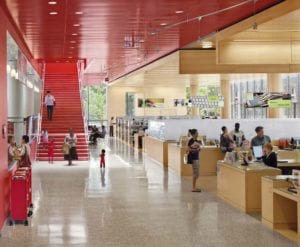Who is a member?
Our members are the local governments of Massachusetts and their elected and appointed leadership.

The Cambridge Public Library’s main branch is a modern building that meets the varied needs of the city’s population. (Photo courtesy Robert Benson Photography)
The Massachusetts Board of Library Commissioners in mid-November released a free, 160-page guide to planning new or reconfigured public library spaces.
“This space planning guide will not only help plan flexible and efficient library buildings that meet a community’s unique needs,” said Library Building Specialist Lauren Stara, “it will also save communities time and money as they begin exploring options for a new or reconfigured library.”
“Library Space: A Planning Resource for Librarians” creates a formal set of best practices for designing library space that may be applied to libraries across the nation, according to the Board of Library Commissioners. The guide empowers librarians, administrators, space planners and architects with tools for the planning and design of public library buildings. It takes the user through the step-by-step process of determining what to consider when designing a new library for their community, and includes illustrations of different room types, adjacencies, shelving and seating that can be considered for a building project.
Because library services are changing so rapidly, formal standards for space planning have been lacking for many years. Massachusetts Public Library Construction Program staff worked closely with the Boston-based global design firm Sasaki for more than a year to develop the planning resource. The process included a series of site visits to recently constructed or renovated public libraries across the Commonwealth, an in-depth analysis of 13 selected case study libraries, and a focus group with the directors of the case study libraries to discuss the successes and shortcomings of their completed buildings and the planning process.
Since 1987, the MBLC’s Massachusetts Public Library Construction Program has guided communities through more than 200 projects. The program is nationally recognized and serves as a model for other states.